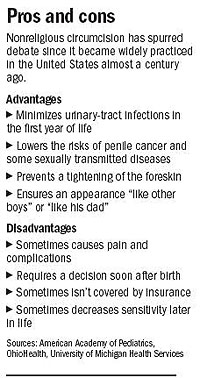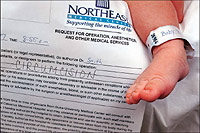Columbus Dispatch (Ohio). Sunday, 15 January 2006.
Columbus Dispatch (Ohio). Sunday, 15 January 2006.


For most central Ohio boys, life begins with cosmetic surgery. Shortly after birth, they are restrained, anesthetized and shorn of their foreskin.
Historically, circumcision has been a routine procedure in the United States, but the rate dipped to a 50-year low of 55.9 percent in 2003, the most recent figures available from the Centers for Disease Control and Prevention.
Nationally, the rate dropped 7.2 percent between 2001 and 2003.
Health-care professionals attribute the decline to the lack of medical reasons for doing the procedure and a rise in the number of immigrants from countries where it is not performed.
In Ohio and the rest of the Midwest, the rate remains the nations highest at 77.8 percent, although it is dropping slightly here as well.
Central Ohio hospitals and pediatric practices report rates similar to the Midwest average.
For example: About 80 percent of the 1,200 boys born at Grant Medical Center each year are circumcised, said Dr. Craig W. Anderson, director of newborn medicine.
Five years ago, it was 90 percent.
Bob and Jane OShaughnessy chose not to circumcise their sons, who are 5 and 8.
said Mrs. OShaughnessy, 33. There didn
t seem to be any good reason to put our children through the discomfort and pain,It seemed pointless to alter their bodies without any compelling medical benefits.
Their decision was influenced by the American Academy of Pediatrics and other major medical societies that dont recommend the procedure.
I would say that all pediatricians in town go with the academy
s party line: This is a cosmetic surgery. There is no medical reason to do it, said Dr. Nancy Hansen, chairwoman of Riverside Methodist Hospitals department of pediatrics.
Many families choose circumcision for cultural reasons, Columbus doctors said.
They don
t want their boys to look funny in the locker room, Hansen said.
Justin and Heidi Green of Hilliard chose circumcision for their two sons, ages 3½ years and 10 months, although they concluded that the procedure is medically unimportant.
We wanted our sons to look like their dad,
Mrs. Green said.
Hygiene often plays a role in the decision, but that really isn
t a good reason to justify circumcision, said Dr. JoAnn Rohyans of Olentangy Pediatrics on the Northwest Side, and spokeswoman for the Ohio Chapter of the American Academy of Pediatrics.
The declining national rate comes while recent research in South Africa indicates that circumcision might reduce the transmission of HIV and other sexually transmitted diseases.
Studies have shown that cultures practicing circumcision are less likely to have HIV,
said Dr. Michael Para, an infectious-disease specialist at Ohio State University Medical Center.
If we can say for sure that circumcision reduces the risk of HIV, then suddenly there clearly is a medical benefit.
For now, evidence is not strong enough to change medical-society policy statements.
Decreases in urinary-tract infections among infants and penile cancer among adults are not significant enough to warrant the procedure, according to the American Medical Association.
Pediatricians consider circumcision to be a simple and safe surgery. The complication rate is less than 1 percent, according to the AMA. The most-common complications are adhesions, bleeding, infection and disfigurement.
Seeing a picture of an infant strapped to a restraint board helped convince the OShaughnessys.
That was the last straw,
Mrs. OShaughnessy said. We were not going to have that done to our babies.
Viewing an online video of the procedure troubled the Greens.
After seeing that, my husband was overwhelmingly against it,
Mrs. Green said, although the couple later changed their minds.
During the past decade, the injection of numbing medication has helped ease pain and trauma.
About 75 percent of my babies sleep through it,
Hansen said.
Pediatricians do most central Ohio circumcisions, although obstetricians, urologists, family doctors and mohels (in the Jewish rite) can also perform them.
Parents have more knowledge and are asking more questions about it,
said Anderson, of Grant Medical Center.
He added that some insurers are refusing to cover the elective procedure.
Medicaid, for example, has stopped paying for circumcisions in 16 states.
Bill Tulloss of the Cincinnati suburb of Evendale is lobbying Ohio to join the movement. Medicaid pays for one-third of Ohio births.
It is just crazy that Medicaid is spending taxpayer money on something that is not necessary at a time when Medicaid expenditures are bankrupting the state,
said Tulloss, a retired college math professor and a member of the National Organization of Circumcision Information Resource Centers.
The Ohio Medicaid program spent $4 million in federal and state money during the past three fiscal years to cover almost 62,000 circumcisions.
It
s one of our smallest expenditures, said Dennis Evans, spokesman for the Department of Job and Family Services.
Dan Bollinger of West Lafayette, Ind., compiles circumcision rates from the CDC, hospital records and other sources for the International Coalition of Genital Integrity.
His statistics have been cited in the Journal of the American Medical Association.
I have been showing a 1 to 2 percent annual decrease for the past 10 years, and I expect that to continue,
said Bollinger, an industrial designer. This is a steady social change that will be long-lasting.
Bollinger is not sure why the Midwest rate leads the nation.
He speculated that it is related to hospital construction in developing industrial centers when circumcision was introduced in the United States during the late 19 th century.
While some parents can readily accept or reject circumcision, others are caught in the middle.
It was a big decision for us to make,
Mrs. Green said. We did a lot of research trying to figure out what to do. We didn
t want to make the wrong decision because we knew it would have a lifelong effect.
The Circumcision Information and Resource Pages are a not-for-profit educational resource and library. IntactiWiki hosts this website but is not responsible for the content of this site. CIRP makes documents available without charge, for informational purposes only. The contents of this site are not intended to replace the professional medical or legal advice of a licensed practitioner.
© CIRP.org 1996-2025 | Filetree | Please visit our sponsor and host:
IntactiWiki.